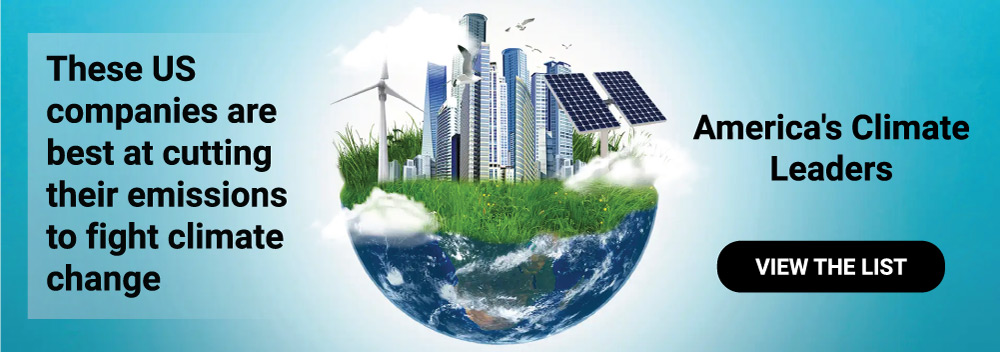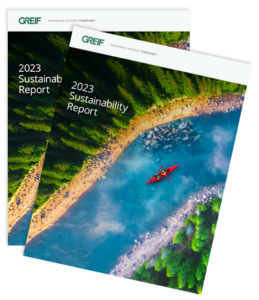Last week, Greif was recognized as a climate leader by USA TODAY. It marks the second year in a row the company made the list for our efforts to reduce greenhouse gas emissions and shrink our carbon footprint.
In recent years, the proliferation of sustainability lists and rankings has become a notable trend. At a time when it feels like there is a new list popping up every year, what does this accolade really mean? Let’s take a closer look at the America’s Climate Leaders list and how it fits with Greif’s broader sustainability targets.
Some Thoughts on Sustainability Lists
A quick google of “sustainability rankings” returns pages of results with everything from heavy brand hitters like USA TODAY, Newsweek, Forbes, Barron’s, Fortune, and Corporate Knights, to smaller, regional, and niche publications, all claiming to have THE list of the “most sustainable”, “greenest”, or “responsible” companies.
Looking past the fact that this is big business – branding and licensing packages for “winners” can easily reach into the tens of thousands of dollars – it is important to understand why sustainability rankings continue to gain attention from investors, consumers, and corporate leaders alike:
- Public awareness and concern over global environmental issues continues to rise.
- There is a lot of noise out there, and lists are an easy way to cut through it.
For consumers, lists help identify which companies are committed to sustainable practices (and which are not), helping them make more informed purchasing decisions. For investors, they offer insights into which companies are likely to be sustainable in the long term, helping them identify opportunities with potentially lower risks and better returns. From a corporate perspective, featuring on these lists can help enhance reputation, attract talent, and motivate internal improvements.
However, the surge in the number of sustainability lists also presents challenges. The criteria and methodologies used to rank companies include complex assessments that vary widely, making it difficult to compare results and nearly impossible to identify good actors from bad.
Despite these challenges, the overall impact of sustainability appears to be positive. They drive companies toward greater accountability and encourage and reward shifts toward more sustainable operations and products.
America’s Climate Leaders List
So where does the “America’s Climate Leaders” list from USA TODAY fall in the grand scheme of things?
The honest answer is it’s too soon to tell. This is only the second year the list has been compiled. When Greif was told we made the cut, we spent a good amount of time digging in to better understand how the final list of 400 companies was chosen.
Here is what we liked:
Rankings Focused on the Largest Companies
To be eligible, USA TODAY looked at 2,000 US-based companies with revenue over $50 million. This is important, as it is widely known a significant portion of the world’s greenhouse gas emissions are from a handful of larger organizations and industries. So, starting with the bigger players makes sense.
Data and Criteria Drawn from Five Different Buckets
- Emission intensity: The amount of greenhouse gas the company produced relative to its revenue. This helps put behemoth companies and big companies on a level playing field.
- Annualized reductions in emission intensity: Companies were ranked by how much they improved their emissions intensity.
- Carbon disclosure rating: A measure of a company’s environmental sustainability. These rankings are administered by CDP, a nonprofit that runs a global disclosure system for companies’ environmental impacts.
- Other criteria: Some enterprises were excluded if known business practices suggested they couldn’t be seen as a climate leader.
- Data used: Scope 1 and 2 emissions, based on the Greenhouse Gas Protocol, the world’s most widely used greenhouse gas accounting standard.
Using CDP scores (CDP is a prominent non-profit known for its emissions reporting and reductions ratings) and Greenhouse Gas Protocol standards – which is the world’s most widely used greenhouse gas accounting standard – means the USA TODAY ranking is using some of the best available data and standards out there.
We also like that the list requires a higher CDP score for larger emitters, and, while acknowledging the importance of Scope 3 emissions, did not include Scope 3 in its evaluation due to the large variation in quality and accuracy in Scope 3 reporting.
Here is what we wanted to like more:
Methodology Rigor
It’s great to include the five different criteria. It’s great to look at the best available data and accounting standards. And it’s smart to focus on the largest companies as the source of the largest emissions. But in an ideal world, we’d like to see it go even further. Things like including data verification and requiring CDP submissions would be good steps. Also, looking at absolute emissions vs emissions intensity would also be high on our wish list as decreasing intensity based on revenue does not necessarily mean total emissions are going down. And I think we can all agree that is ultimately the name of the game here.
We know this is not easy work, and data sets are not only complex, but often contradictory. So this is not necessarily a knock against USA TODAY, as much as it is a reminder for all of us that we can – and we need to – do more. It’s also important to remember that it is far easier to say these things than do these things.
Sustainability at Greif and our 2030 Targets
When it comes to Greif’s sustainability goals, the Climate Leaders list from USA TODAY is an interesting comparison point. It’s one thing to set benchmarks against yourself, it is quite another setting them against an industry or other companies.
In that sense, it’s good to see where Greif fits overall. Good enough to make the final list of 400 companies down from 2,000 – but still a long way to go. The ranking is based on our 2021 and 2022 performance, so where does Greif stand today?
The company just released its FY2023 Sustainability Report, making it the 15th consecutive year the company has issued the publication. The 132-page report is a full accounting of our progress on emissions and waste reduction, DEI, fair labor practices, and health & safety.
VIEW THE GREIF SUSTAINABILITY REPORT
We have issued annual sustainability reports since 2009. Launch our report to learn more about our sustainability strategy and progress against our performance goals and sustainability commitments.
When it comes to reducing greenhouse gas emissions and shrinking our carbon footprint specifically, we made considerable progress. Page 26 of the report details our Climate Strategy. Highlights from the year include:
- Adding a new senior level leader to the company who is charged with accelerating our decarbonization efforts
- Adding 15 new high impact decarbonization projects to the company’s decarbonization roadmap focused on lowering emissions from our mills and adding new renewable energy capacity
- A refined Scope 3 emissions methodology that improves data collection and integration efforts
- A 11.5% absolute reduction in Scope 1 and Scope 2 greenhouse gas (GHG) emissions compared 2022
How does this progress stack up against our 2030 targets? We’re glad you asked. Our emissions target before the end of this decade is to reduce absolute Scope 1 and Scope 2 GHG emissions 28 percent from a 2019 baseline.
In FY2023 we have reduced our absolute Scope 1 and Scope 2 emissions 11.5% from 2022.
To learn more about sustainability at Greif, we invite you to read our 2023 Sustainability Report. Make sure you refill your coffee first so you’re properly fueled to review the full 132-pages!



